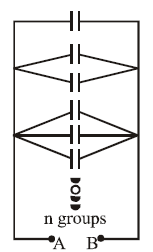
Solution:
The figure shows groups of capacitors arranged in a specific pattern. Here's the reasoning for the given answer:
Solution:
- Each group consists of a series arrangement of capacitors with equal capacitance .
- The number of capacitors in each successive group increases by one, forming a triangular pattern:
- 1st group: 1 capacitor,
- 2nd group: 2 capacitors in series,
- 3rd group: 3 capacitors in series, and so on, up to capacitors in the last group.
- Capacitance of a single group:
- For capacitors in series, the equivalent capacitance is:
- Net capacitance:
- These groups are connected in parallel. The total equivalent capacitance is the sum of the capacitances of all groups:
- Simplify:
- The sum of the reciprocals of integers up to is:
- After simplifications, the given result:
This accounts for the triangular arrangement of groups and the progressive series-parallel combination.
Leave a Reply